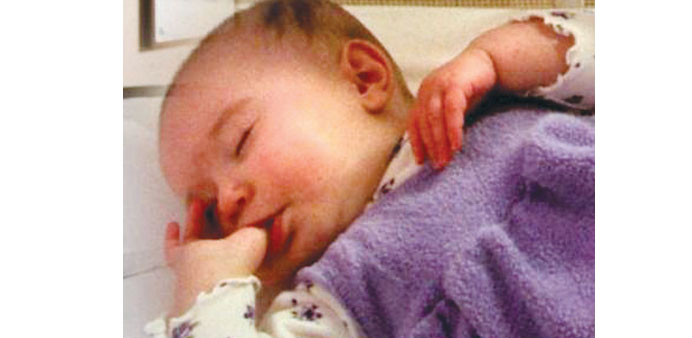|
The most tragic event that can befall new parents is the sudden, unexpected death of their baby. Perhaps the only thing worse is the parents being wrongly accused of causing the death, and indeed prosecuted, owing to the medical community’s misinterpretation of the findings. |
A small number of babies who collapse and die unexpectedly in their first year are found to have one or more of the following three symptoms in common: bleeding just outside the brain (subdural haemorrhage); bleeding at the back of the eye (retinal haemorrhage); and brain swelling.
These same features are also seen in some babies who have suffered trauma, such as falls or motor-vehicle accidents. Yet many babies with these symptoms have no history or medical evidence of trauma (such as fractures, abrasions, or bruises), physical abuse, or neglect.
Paediatricians wrestled with this conundrum until the 1970’s, when it was proposed that shaking might induce rotational forces and cause the “triad” of symptoms without bruises or fractures. Over the years, these findings evolved into “shaken baby syndrome” (SBS), a medico-legal hypothesis that remains contentious, and scientifically unproven, to this day.
The SBS hypothesis attributed the triad of symptoms to the physical rupture of blood vessels on the brain’s surface and in the retina, and the tearing of nerve fibers within the brain. It was suggested that these outcomes required a force equivalent to a multi-storey fall or major motor-vehicle accident, causing immediate symptoms or collapse. Because violent shaking cannot be accidental, the hypothesis simultaneously established a criminal act and identified the perpetrator, typically the person with the baby at the time of collapse.
Though the SBS hypothesis was incorporated into medical training and judicial decisions worldwide, it remained untested for almost two decades. In 1987, the first biomechanical experiments found that the force of shaking is much less than that of impact and concluded that shaking alone was unlikely to cause the triad of symptoms.
Subsequent research in my specialty, paediatric neuropathology, established that the medical basis for the SBS hypothesis was also flawed. We learned that the brain damage in these children did not reflect trauma to nerve fibres, but rather a failure of blood supply.
We also learned that the typical subdural haemorrhages in these cases are too thin to result from the rupture of the large bridging veins on the brain’s surface. And we learned that the same findings are seen in natural deaths. In the last decade, the list of other causes – including accidental trauma, congenital causes, and natural illness – has continued to grow.
Perhaps the most compelling observation in recent years is that subdural haemorrhages are present in nearly half of normal, healthy newborns with no evidence of birth trauma. These findings, combined with the immature anatomy of the infant dura, suggest that dural bleeding in young babies may be a natural protective device – a reservoir to prevent backflow into the brain’s blood vessels during the pressure fluctuations of normal labour and delivery.
Because these anatomical features persist into early childhood, the dura may remain similarly vulnerable to bleeding beyond the newborn period. Indeed, both birth-related bleeds and those attributed to shaking are most often located in the folds of membranes covering the brain that have more and larger blood vessels at this age than later in life.
While scientific evidence over the last three decades has undermined the shaken baby hypothesis, no new evidence has emerged to support it.
Instead, several researchers have relied upon the data in older studies to calculate the statistical probability of inflicted brain injury when certain features (such as intracranial haemorrhage, retinal haemorrhage, brain swelling, and seizures) are present. These probabilities are then offered as the basis for diagnosis and as evidence in court.
However, the reasoning behind the studies on which these researchers rely is circular, and based on assumptions now known to be unreliable. For example, in some studies, the researchers decided arbitrarily that falls of less than one meter could not harm a baby, so that parents who described such a fall must be lying.
Other studies viewed the parents’ inability to explain the findings as evidence of abuse.
Given these flaws, reviews of old studies do not provide a reliable evidence base for diagnosing abuse. They simply predict the likelihood that specific findings will be categorised as abusive, and that, consequently, the child’s caregiver at the time will be accused or convicted of abuse, regardless of the accuracy of the diagnosis.
Leading proponents of the SBS hypothesis now acknowledge that the triad is a “myth”, that SBS diagnoses consist of “informed speculation”, and that the hypothesis is supported solely by confessions. Some courts are following suit, with one US federal judge describing the types of confessions obtained as “worthless as evidence”, and another noting that, given recent developments, claims of SBS may be “more an article of faith than a proposition of science”.
No one questions whether infants can be damaged or killed by violent shaking or abuse; of course they can. The real issue is whether shaking or abuse can be inferred on the basis of a hypothesis that lacks scientific support.
In no other area of medicine and law would an unproved hypothesis provide a basis for diagnosis, let alone criminal prosecution.
Given the developments of the past decade, we now face the possibility that for the past 30 years we have been wrongly imprisoning parents on the basis of a flawed hypothesis. - Project Syndicate
♦ Waney Squier is a paediatric neuropathologist at the John Radcliffe Hospital, Oxford.

